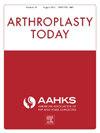新型增强现实技术辅助全膝关节置换术的准确性:体内研究
IF 1.5
Q3 ORTHOPEDICS
引用次数: 0
摘要
背景全膝关节置换术(TKA)仍是治疗终末期膝关节骨性关节炎的标准疗法。大约 15%-20%的患者对术后效果不满意。为了提高膝关节置换术的准确性和疗效,人们引入了各种辅助技术。本研究对增强现实(AR)系统进行了探索和测试。方法 Knee + 系统(Pixee Medical,法国贝桑松)用于指导 TKA。该系统结合使用快速反应代码标记的器械和 AR 眼镜来引导胫骨和股骨切口。主要研究目标是通过直接比较股骨外侧远端角度、胫骨内侧近端角度、髋膝踝轴线和胫骨斜度的计划角度值与术中获得的角度值以及术后全腿X光片上测量的角度值,评估其准确性。这项回顾性研究对 124 名患者进行了评估,随访时间至少 1 年。股骨远端外侧角的计划值与术后测量值的平均绝对差值为1.39°,胫骨近端内侧角为1.03°,胫骨斜度为2.16°,髋-膝-踝轴线为1.51°。在随访期间,共观察到 8 例并发症。结论这项研究表明,Knee + AR 系统具有很高的准确性,可与机器人辅助全膝关节置换术相媲美。对于接受内侧枢轴 TKA 的患者来说,它是一种安全、廉价、省时的辅助技术。本文章由计算机程序翻译,如有差异,请以英文原文为准。
Accuracy of a New Augmented Reality Assisted Technique for Total Knee Arthroplasty: An In Vivo Study
Background
Total knee arthroplasty (TKA) remains the standard of care for treating end-stage osteoarthritis of the knee. Approximately 15%-20% of the patients are dissatisfied following surgery. To improve accuracy and outcomes of TKA, various assistive technologies have been introduced. For this study, an augmented reality (AR) system was explored and tested.
Methods
The Knee + system (Pixee Medical, Besancon, France) was used to guide TKA. It uses a combination of quick response-code labeled instruments and AR glasses to guide tibial and femoral cuts. The primary research goal was to evaluate its accuracy by direct comparing the planned angular values for lateral distal femoral angle, medial proximal tibial angle, hip-knee-ankle axis, and tibial slope to the intraoperative obtained values and the measured angles on postoperative full leg radiographs. The secondary research goal was to assess its feasibility.
Results
This retrospective study evaluated 124 patients, with a follow-up of at least 1 year. The average absolute difference between planned and measured postop values were 1.39° for lateral distal femoral angle, 1.03° for medial proximal tibial angle, 2.16° for tibial slope, and 1.51° for hip-knee-ankle axis. Within the follow-up period, 8 complications were observed. The average surgical time was 83 minutes.
Conclusions
This study has demonstrated a high accuracy, comparable to robotic-assisted total knee arthroplasty, of the Knee + AR system. It has shown to be a safe, cheap and time-efficient assistive technology for patients undergoing medial pivot TKA.
求助全文
通过发布文献求助,成功后即可免费获取论文全文。
去求助
来源期刊

Arthroplasty Today
Medicine-Surgery
CiteScore
2.90
自引率
0.00%
发文量
258
审稿时长
40 weeks
期刊介绍:
Arthroplasty Today is a companion journal to the Journal of Arthroplasty. The journal Arthroplasty Today brings together the clinical and scientific foundations for joint replacement of the hip and knee in an open-access, online format. Arthroplasty Today solicits manuscripts of the highest quality from all areas of scientific endeavor that relate to joint replacement or the treatment of its complications, including those dealing with patient outcomes, economic and policy issues, prosthetic design, biomechanics, biomaterials, and biologic response to arthroplasty. The journal focuses on case reports. It is the purpose of Arthroplasty Today to present material to practicing orthopaedic surgeons that will keep them abreast of developments in the field, prove useful in the care of patients, and aid in understanding the scientific foundation of this subspecialty area of joint replacement. The international members of the Editorial Board provide a worldwide perspective for the journal''s area of interest. Their participation ensures that each issue of Arthroplasty Today provides the reader with timely, peer-reviewed articles of the highest quality.
 求助内容:
求助内容: 应助结果提醒方式:
应助结果提醒方式:


